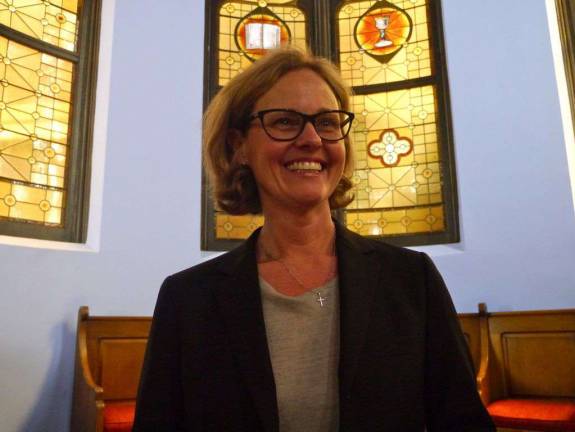At An East Side Church, Profiting From Change

The Rev. Beverly Dempsey traded in corporate power for a higher power. After years as a marketing specialist for corporate food giants, she made a subtle, but profound career change. “Now I'm going to do marketing for God,” she told herself.
In just a few months at Jan Hus Presbyterian Church and Neighborhood House, Dempsey has instituted a number of changes.
She moved the celebration of the Sabbath from Sunday to Tuesday, introduced Spanish services and planned renovations to the church, which was built in 1888. On Sunday, she will be formally installed in her new executive post — the congregation's 12th pastor. Before she enrolled at Union Theological Seminary in Morningside Heights in 2001, Dempsey's career revolved around profit-making. She traded currencies for Maryland National Bank out of college and then went on to earn an MBA in strategic marketing from the University of Minnesota. She then spent years doing marketing and consulting for General Mills, Heinz and Nabisco.
“Not many pastors have done strategic business plans for the biggest businesses in the world,” she said.
The church still holds a full worship service, with communion, on the first Sunday of each month and an educational hour every other Sunday. Weekdays are also busy. Dempsey runs the church and the Neighborhood House, a social services operation for the homeless, from a long, rectangular office on the second floor. Tall, closely spaced windows line the walls on two sides, keeping Dempsey exposed and connected to activity both in the sanctuary and on East 74th Street below.
When she arrived at Jan Hus in September 2014, the room was being used for the church's clothing distribution program. Clothes for men, women and children piled up on a long wooden table that Dempsey now uses to meet with various church committees. Her own office was a windowless, closet-like space downstairs, an unnatural place for someone trying to show people the light.
With a simple switch, she moved herself into a more central location within the church and the clothes into a space that provides more privacy for people browsing for a new wardrobe. There are now separate clothing rooms for men, women and children.
At Jan Hus, Dempsey's management style is a natural fit. “This is not what a sanctuary normally looks like,” she said as she passed through the space used for worship. With high ceilings, stained-glass windows and a large Czech oil painting of the church's martyr namesake, the ambiance is familiar, except for one thing: the church has no pews.
In the 1960s, church leaders wanted to use the sanctuary to hold a luncheon group for the aged. City officials, though, turned down a request for funds, saying the Jan Hus lacked adequate space. In response, church members pulled out the pews so that they could use the space as they wanted. The luncheon group still meets there today. “It was one of those classic, kind of 'I'll show you' moments that I'm pretty fond of,” Dempsey chuckled.
These days, her divine marketing strategy has to appeal to a focus group as diverse as the Upper East Side's population. “We're creating a sacred community center that embraces all people equally,” she said.
Social service programs at Jan Hus, mostly focused on the homeless, are a major part of the church's activities and serve about 6,000 people from an annual budget of $800,000. About 600 people receive mail there. About 100 come weekly for a hot meal, a number Dempsey hopes to increase to 125.
However, Dempsey sees a challenge in balancing this social service work with serving the rest of the community. “There's a stigma about being the homeless church,” she said. “Not everyone wants to be a part of that conversation.”
While she has plans to expand programs and facilities for the homeless, including the renovation of Neighborhood House's shower room, she is also looking to reach the rest of the neighborhood. Her decision to change weekly services from Sunday to Tuesday came after she looked out the window and asked herself, “When is the neighborhood thriving?” She noticed that many people leave the city on weekends, while others visit soup kitchens in other parts of the city.
“It makes sense to me that we bring worship to the people,” she said. That means holding service on the community's schedule, not the church's, she said.
Dempsey has already seen progress since her arrival. Six new members have joined the church, which, for this small congregation, represents a 60 percent increase. The gain is modest, but it makes her optimistic. “If we can do that every six months,” she said, “we'll be in pretty good shape.”